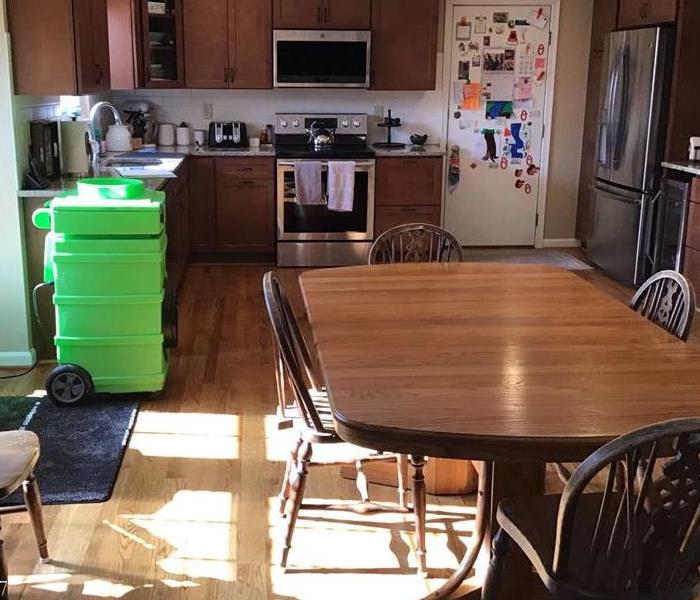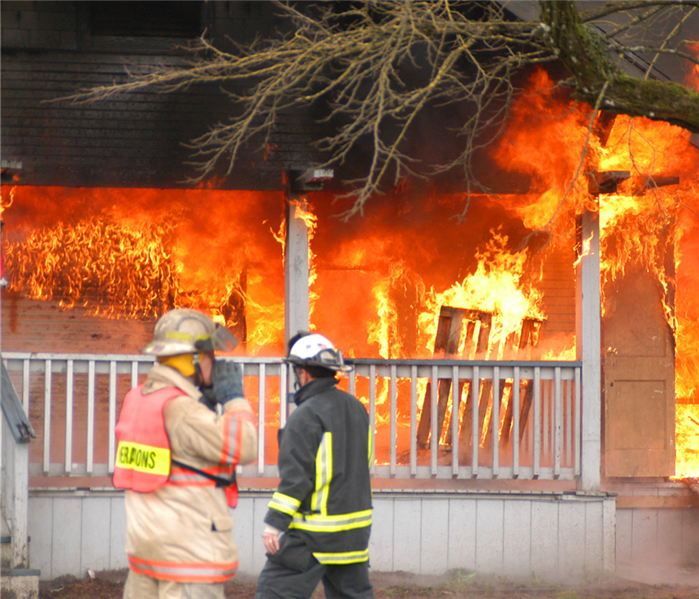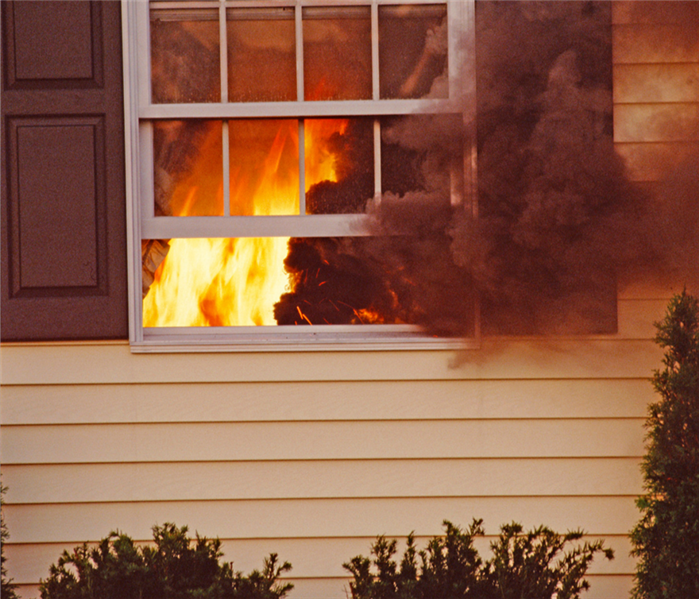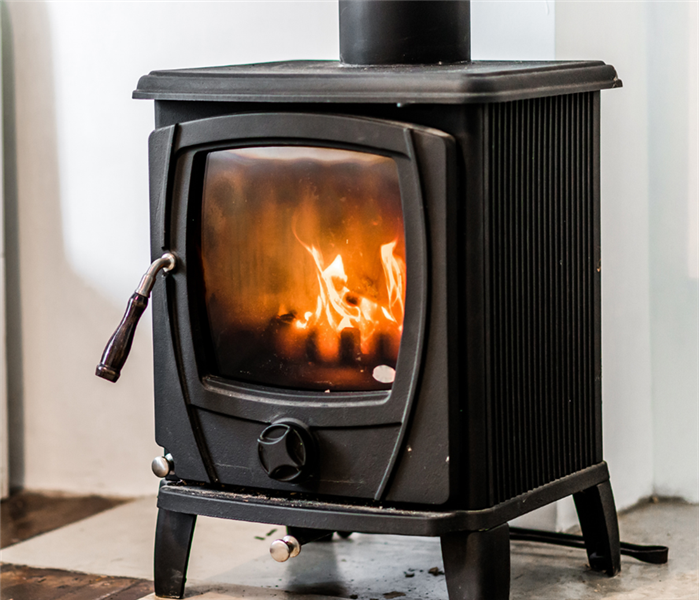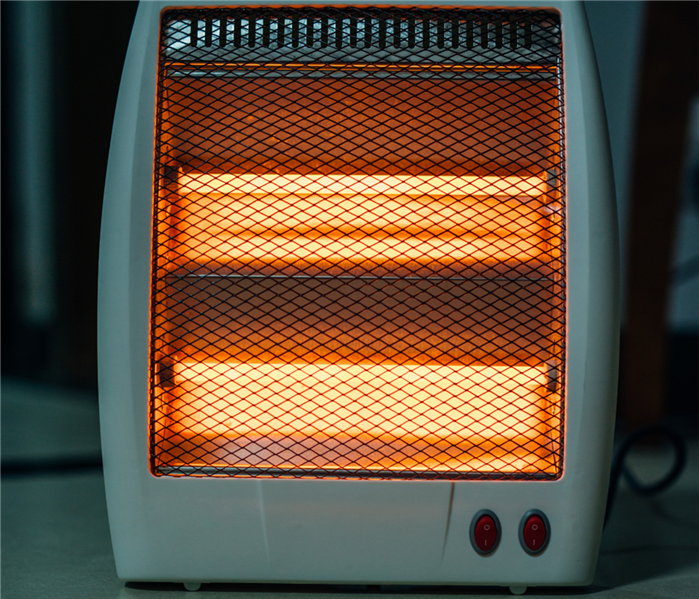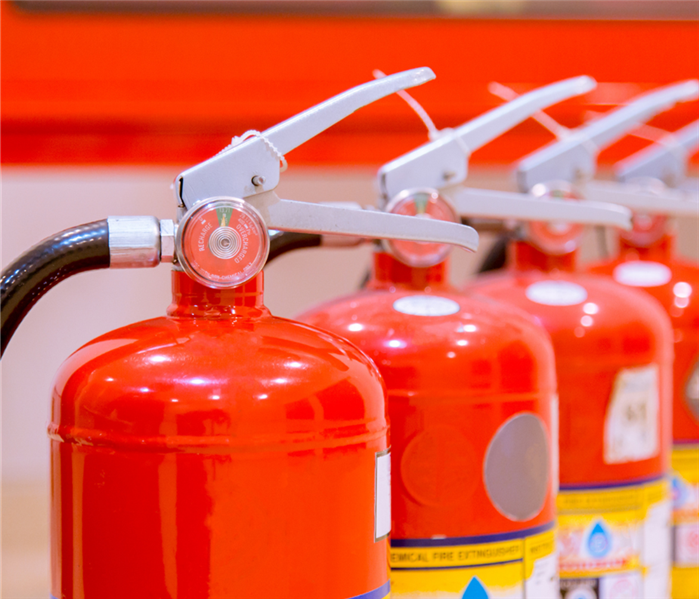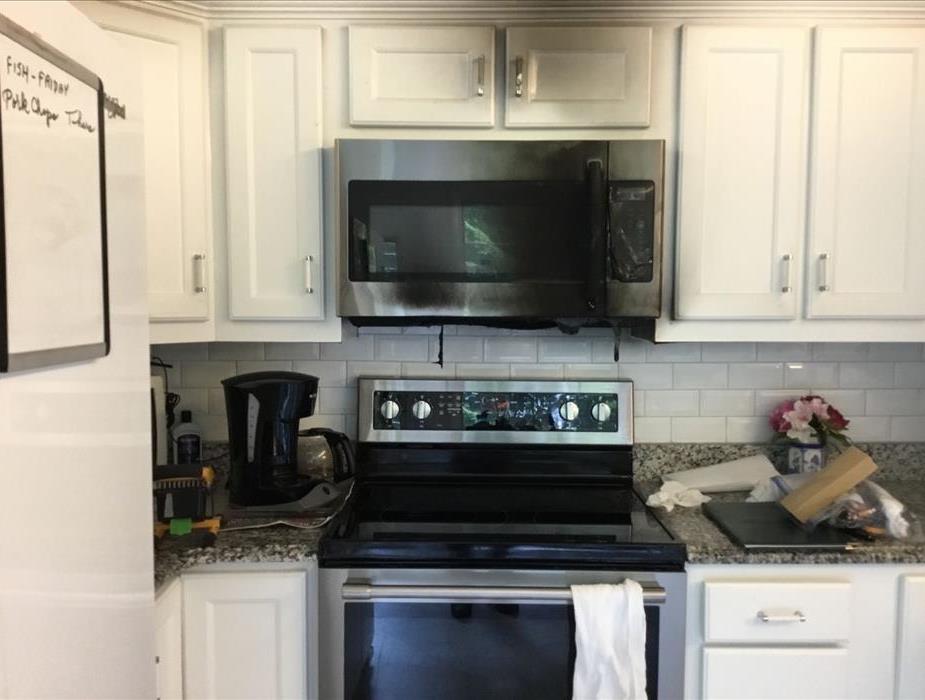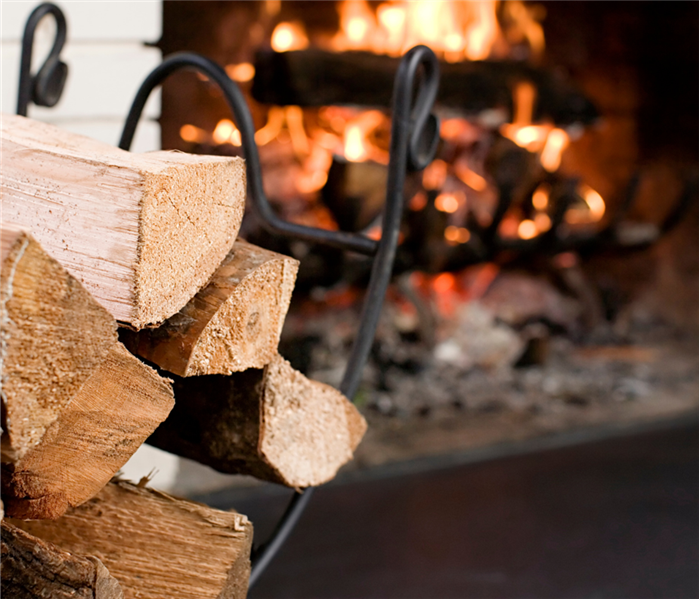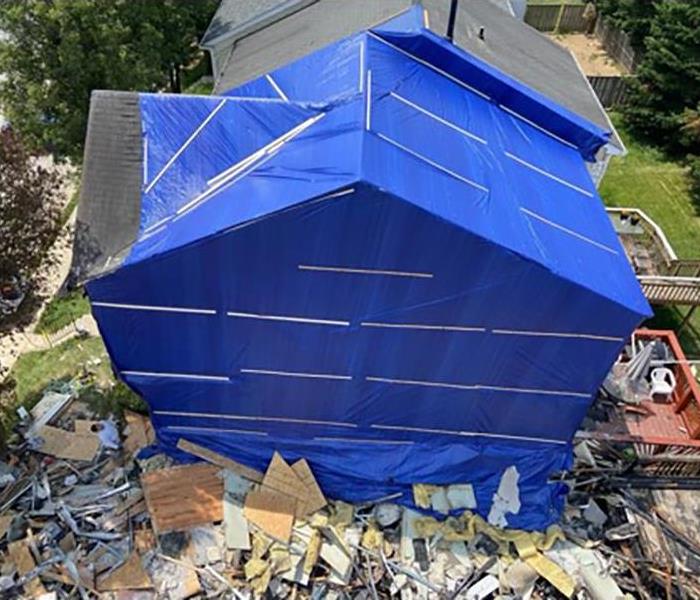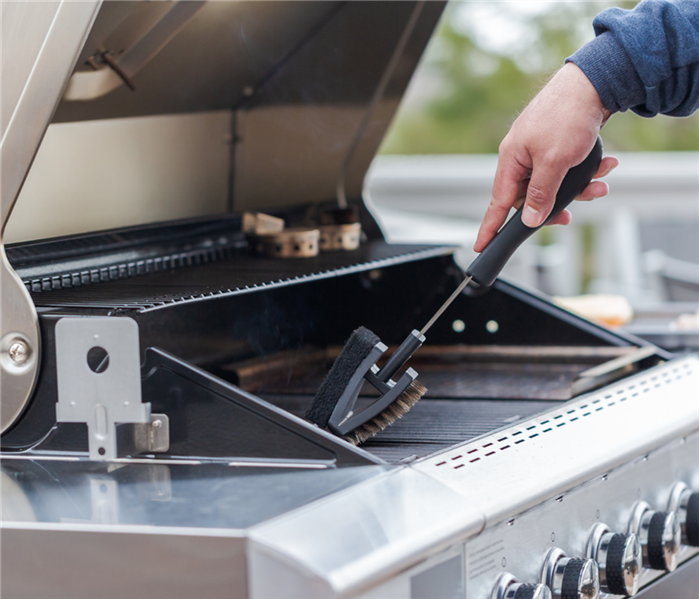Archived Fire Damage Blog Posts
THANKSGIVING FIRE SAFTEY TIPS
11/7/2024 (Permalink)
During the holidays, especially on Thanksgiving, the kitchen becomes a central hub for family gatherings, but with increased cooking activity comes a higher risk of kitchen fires;therefore, it's crucial to prioritize fire safety bystaying attentive while cooking, keeping children away from the stove, and ensuring all appliances are handled carefully to prevent accidents and protect your loved ones.
Key points to remember:
- Thanksgiving is the peak day for home cooking fires:Statistics show that more cooking fires occur on Thanksgiving than any other day, with unattended cooking being the primary cause.
- Stay in the kitchen while cooking:Never leave the stove unattended when cooking, and always keep an eye on your food.
- Supervise children closely:Keep children at a safe distance from the stove and hot food, and ensure they cannot reach knives or other sharp utensils.
Avoid tripping hazards by keeping the floor clear of clutter, toys, and bags.
- Secure cords and appliances:Make sure electrical cords from appliances like coffee makers or mixers are not dangling within easy reach of children.
- Store matches and lighters safely:Keep matches and lighters out of children's reach, ideally in a locked cabinet.
- Check smoke alarms:Regularly test your smoke alarms to ensure they are functioning properly.
Every fire and smoke damage scenario is unique, demanding a customized approach based on the specific situation;with our specialized equipment, extensive knowledge, and proven experience, SERVPRO of Catonsville can effectively restore your property from fire and smoke damage, while treating your family with compassion and your belongings with utmost care.
SERVPRO of Catonsville specializes in the cleanup and restoration of residential and commercial property after a fire, smoke or water damage event. Our staff is highly trained in property damage restoration and we are an IICRC Certified Firm. Have Questions about Fire, Smoke, or Soot Damage? Call us at 410-242-7370
Top Three Causes of Fires!
2/1/2023 (Permalink)
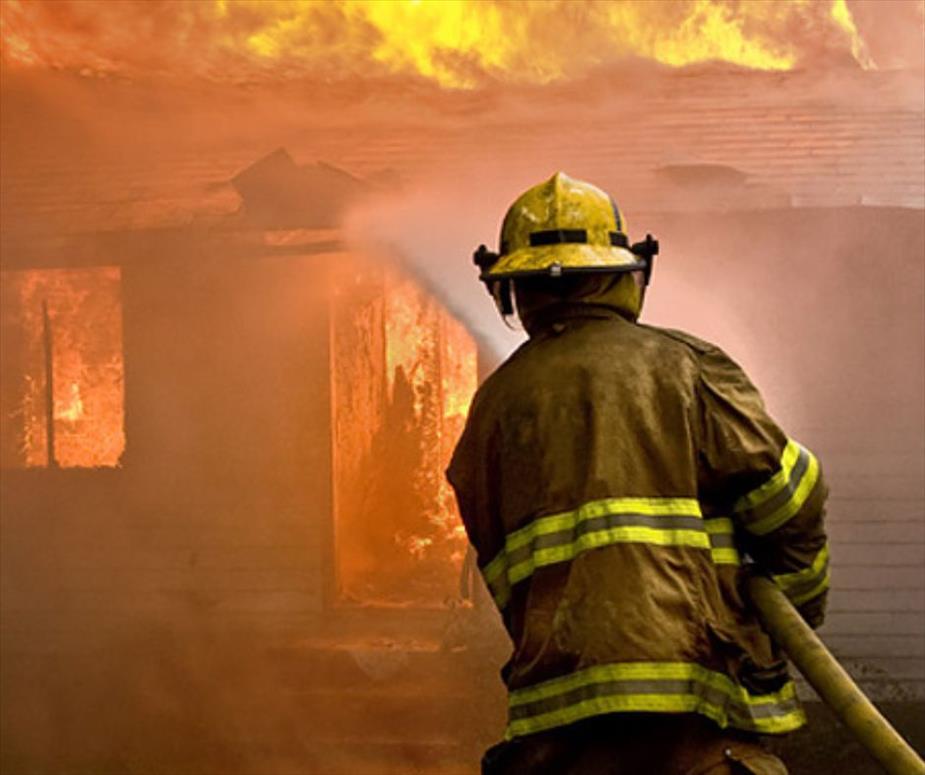 Fire
Fire
Did you know that the top three causes of residential fires include cooking, heating and electric systems/equipment. Now that we have established the top three reasons as to how these calamities begin, let’s discuss each cause in more depth so you are able to determine how each can be avoided.
- Cooking: Causing nearly half of home fires, cooking-related fires are also, unfortunately, the second leading cause for residential fire deaths. These fires peak during the holidays, first Thanksgiving, followed by Christmas. Unattended cooking plays a large role in how fires begin. Other factors include grease and oil. Heating oil too quickly can cause fires. Leaving grease on the stovetop can also create fires. Leaving common kitchen items such as over mitts and food wrappers on or near the stove can also start fires.
- Heating: Spiking during the cold winter months of December, January and February, heating fires typically stem from space heaters, fireplaces and wood stoves. While it may be tempting to keep your portable heater right near you on the chilliest of days, fires can easily be created if furnishing or personal belongings, such as mattresses and blankets, are within 3 feet of the space heater. Fires also start when heating sources such as space heaters or fireplaces are left unattended.
- Electric: Wiring, cords (including extension cords), lighting, and plugs all fall under the umbrella of electric distribution. Malfunction and damage, such as fraying, are a couple reasons as to why fires begin from electric distribution. Faulty electrical outlets cause fires, as do worn out sockets. Using an unqualified electrician to install or update wiring, lighting, etc. is another reason why fires may begin in your home. Additionally, the exposure of water to electricity can create fire.
Be sure to be mindful if you smoke, light candles, use a grill, or have children and/or pets, as these are a few other leading causes of residential fires. Taking caution and remaining vigilant can greatly help keep you, your family and home safe!
An Oven Malfunction
9/6/2022 (Permalink)
When you think of fire damage, you probably think about damage due to flames and smoke, however, soot damage can also present a serious challenge.
Recently, our team was called to a home where an oven malfunction dispensed soot throughout the kitchen as well as several other rooms of the home.
To fix the damage and restore the home to its previous condition, our highly trained crews cleaned all the flooring and upholstery throughout and set up air scrubbers with charcoal filters to help with the odor removal.
The homeowners were incredibly impressed with our team and our work and left us with high praise.
--
About SERVPRO of Catonsville
SERVPRO of Catonsville specializes in the cleanup and restoration of residential and commercial property after a fire, smoke or water damage event. Our staff is highly trained in property damage restoration and we are an IICRC Certified Firm. SERVPRO of Catonsville is locally owned and operated—so we live and work here, too and we are proud to be part of the Catonsville community.
How To Make a Fire Escape Plan
9/5/2022 (Permalink)
When your home is on fire, every second counts.
We consulted the National Fire Protection Association to bring you the following tips so you can be prepared with an escape plan in the unfortunate event of a fire in your home:
• Pull together everyone in your household and make a plan. Walk through your home and inspect all possible exits and escape routes. Households with children should consider drawing a floor plan of your home, marking two ways out of each room, including windows and doors. Also, mark the location of each smoke alarm.
• A closed door may slow the spread of smoke, heat and fire. Install smoke alarms in every sleeping room, outside each sleeping area and on every level of the home.
• When you walk through your plan, check to make sure the escape routes are clear and doors and windows can be opened easily.
• Choose an outside meeting place (i.e. neighbor's house, a light post, mailbox, or stop sign) a safe distance in front of your home where everyone can meet after they've escaped. Make sure to mark the location of the meeting place on your escape plan.
• Go outside to see if your street number is clearly visible from the road. If not, paint it on the curb or install house numbers to ensure that responding emergency personnel can find your home.
• Have everyone memorize the emergency phone number of the fire department. That way any member of the household can call from a neighbor's home or a cellular phone once safely outside.
• If there are infants, older adults, or family members with mobility limitations, make sure that someone is assigned to assist them in the fire drill and in the event of an emergency. Assign a backup person too, in case the designee is not home during the emergency
• If windows or doors in your home have security bars, make sure that the bars have emergency release devices inside so that they can be opened immediately in an emergency. Emergency release devices won't compromise your security - but they will increase your chances of safely escaping a home fire.
• Tell guests or visitors to your home about your family's fire escape plan. When staying overnight at other people's homes, ask about their escape plan. If they don't have a plan in place, offer to help them make one. This is especially important when children are permitted to attend "sleepovers" at friends' homes.
• Be fully prepared for a real fire: when a smoke alarm sounds, get out immediately.
• Once you're out, stay out! Under no circumstances should you ever go back into a burning building. If someone is missing, inform the fire department dispatcher when you call. Firefighters have the skills and equipment to perform rescues.
Put your plan to the test:
• Practice your home fire escape plan twice a year, making the drill as realistic as possible.
• Make arrangements in your plan for anyone in your home who has a disability.
• Allow children to master fire escape planning and practice before holding a fire drill at night when they are sleeping. The objective is to practice, not to frighten, so telling children there will be a drill before they go to bed can be as effective as a surprise drill.
• It's important to determine during the drill whether children and others can readily waken to the sound of the smoke alarm. If they fail to awaken, make sure that someone is assigned to wake them up as part of the drill and in a real emergency situation.
• If your home has two floors, every family member (including children) must be able to escape from the second floor rooms. Escape ladders can be placed in or near windows to provide an additional escape route. Review the manufacturer's instructions carefully so you'll be able to use a safety ladder in an emergency. Practice setting up the ladder from a first floor window to make sure you can do it correctly and quickly. Children should only practice with a grown-up, and only from a first-story window. Store the ladder near the window, in an easily accessible location. You don't want to have to search for it during a fire.
• Always choose the escape route that is safest – the one with the least amount of smoke and heat – but be prepared to escape under toxic smoke if necessary. When you do your fire drill, everyone in the family should practice getting low and going under the smoke to your exit.
• Closing doors on your way out slows the spread of fire, giving you more time to safely escape.
• In some cases, smoke or fire may prevent you from exiting your home or apartment building. To prepare for an emergency like this, practice "sealing yourself in for safety" as part of your home fire escape plan. Close all doors between you and the fire. Use duct tape or towels to seal the door cracks and cover air vents to keep smoke from coming in. If possible, open your windows at the top and bottom so fresh air can get in. Call the fire department to report your exact location. Wave a flashlight or light-colored cloth at the window to let the fire department know where you are located.
--
Each fire damage situation is different, so each one requires a unique solution tailored for the specific conditions. SERVPRO of Catonsville has the equipment, expertise, and experience to restore your fire and smoke damage. We will also treat your family with empathy and respect and your property with care.
Have Questions about Fire Damage?
Call Us Today – 410-242-7370
You Had a Fire - What Happens Next?
2/20/2022 (Permalink)
The following checklist serves as a quick reference and guide to follow after a fire in your home.
- Check with the fire department to make sure your residence is safe to enter. Be watchful of any structural damage caused by the fire
- The fire department should see that utilities are either safe to use or are disconnected before they leave the site. DO NOT attempt to reconnect utilities yourself.
- Contact your local disaster relief service, such as The Red Cross, if you need temporary housing, food and medicines.
- If you are insured, contact your insurance company for detailed instructions on protecting the property, conducting inventory and contacting fire damage restoration companies. (SERVPRO of Catonsville is approved by all insurance companies.)
- Conduct an inventory of damaged property and items. Do not throw away any damaged goods until after an inventory is made. Try to locate valuable documents and records-deed to home, car, bank information, birth certificates, etc.
- Begin saving receipts for any money you spend related to fire loss. The receipts may be needed later by the insurance company and for verifying losses claimed on income tax
- Notify your mortgage company of the fire.
Since each smoke and fire damage situation is a little different, each one requires a unique solution tailored for the specific conditions. At SERVPRO of Catonsville, we have the equipment, expertise, and experience to restore your fire and smoke damage. We will also treat your family with empathy and respect and your property with care.
Have Questions about Fire, Smoke, or Soot Damage? Call Us Today – 410-242-7370
Home Heating Safety Tips: Part 1
2/18/2022 (Permalink)
It’s feeling like winter again here in Catonsville, which means turning up the heat and staying as cozy as possible at home, something you probably do without much thought. However, with anything that has potential to cause a fire, it’s a good idea to exercise caution, especially with space heaters, fireplaces, and wood burning stoves.
Check out these tips for Wood Burning Stoves:
- Install the stove, chimney connectors and chimneys following manufacturer’s instructions or have a professional do the installation.
- Wood stoves should bear the label of a recognized testing laboratory.
- In wood stoves, burn only dry, seasoned wood. In pellet stoves, burn only dry, seasoned wood pellets.
- Start the fire with newspaper or kindling, never with a flammable liquid, such as lighter fluid, kerosene or gasoline.
- Keep the doors of your wood stove closed unless loading or stoking the live fire.
- Allow ashes to cool before disposing. Dispose of ashes in a tightly covered metal container and keep the ash container at least 10 feet away from the home and any other nearby buildings. Douse and saturate with water.
- Chimneys and vents need to be cleaned and inspected at least once a year.
Have questions about Fire prevention or Fire, Smoke, or Soot Damage? Call us at 410-242-7370. We’re here to help.
Space Heater Safety
2/13/2022 (Permalink)
When cold weather hits, many of us have considered a space heater to provide a little extra warmth in a cold room in a big house or even under a desk at work.
This small but mighty appliance has many advantages:
• Quickly heats small areas
• Provides supplemental heat for a larger space
• Very portable and easy to move around
• Helps defray utility costs
• Easy to find and relatively inexpensive
While these are all great reasons to use a space heater, you’re right in being concerned about safety. When Space Heaters are operated incorrectly, they become a MAJOR fire hazard.
Luckily, you can help prevent disaster by following these simple steps:
1. Position your heater AT LEAST 3 feet away from other objects: walls, furniture, curtains, bedding, clothing, etc.
2. Place your heater on a flat, sturdy surface. Never place on tables, chairs, or other areas where it may get bumped into or knocked over.
3. Always plug your heater directly into a wall outlet. Do not use extension cords.
4. Never use your heater near water or to dry clothing or textiles. Do not operate with wet hands.
5. Place your heater in an area away from children and pets. Don’t allow children to operate the heater without proper supervision.
6. Turn off the heater before you go to bed or leave the house.
A little extra precaution will go a long way to ensuring the safety of your home and family.
Have Questions about Fire, Smoke, or Soot Damage? Call us at 410-242-7370.
How to Use A Fire Extinguisher
1/9/2022 (Permalink)
As a homeowner or business owner you need to be prepared for emergencies. If you've ever had a fire and had to call in professionals to restore your home or business, you understand the importance of having a fire extinguisher on hand. Following the steps below can ensure that you're using it correctly.
1. Assess the Situation
First, understand what you're dealing with. If the blaze is already too big, the best course of action is to call the fire department and get yourself and anyone else in the house to safety. If you can safely douse it with a fire extinguisher, you need to next make sure that you have right type for whatever material is burning.
2. Use the Right Extinguisher for the Fire
Experts classify extinguishers based on the type of fire they can combat. These include:
- Type A: for fires involving plastics, wood, textiles and paper
- Type B: used on fires involving solvents, gasoline, oils, paints and other flammable liquids
- Type C: for electrical fires, including plugged-in equipment like computers or appliances
- Type D: for fires involving combustible powders or metals
- Type E: commonly used for a kitchen fire involving fats or cooking oils
These letter classifications are always found on the sides of the extinguishers, many of which are rated for putting out fires of more than one type.
3. Remember: "PASS"
The PASS method is an easy way to remember how to use most fire extinguishers. Each letter in "PASS" stands for the first word of an operational step.
- "P": Pull the pin at the top of the extinguisher; it needs to be removed before operation.
- “A": Aim the nozzle. The nozzle should not be aimed at the top of the flames, but at the bottom where the combustion is taking place.
- "S": Squeeze the handle to start the flow.
- “S”: Sweep from side to side while spraying.
By acting quickly and following the instructions above, you can quickly and safely prevent fire damage.
--
Every fire damage situation is different and each one requires a unique solution tailored for the specific conditions. At SERVPRO of Catonsville, we have the equipment, expertise, and experience to restore your fire and smoke damaged property and contents. We will also treat your family with empathy and respect and your property with care.
Have questions about Fire & Smoke Damage? We’re here to help. Call us at 410-242-7370.
--
About SERVPRO of Catonsville
SERVPRO of Catonsville specializes in the cleanup and restoration of residential and commercial property after a fire, smoke or water damage event. Our staff is highly trained in property damage restoration and we are an IICRC Certified Firm. SERVPRO of Catonsville is locally owned and operated—so we live and work here, too and we are proud to be part of the Catonsville community.
A Kitchen Fire
11/3/2021 (Permalink)
Not every home fire results in a major loss of the structure, but can still be terrifying and cause damage throughout the home.
Recently, we were called to a home after a cooking accident caused a kitchen fire. While cooking, the homeowner left the room to attend to another matter, lost track of time, and a fire broke out causing overhead microwave to melt and resulting in soot damage throughout the kitchen, living & dining rooms of home.
Our crew ensured that the microwave was unplugged to prevent further safety hazards. Then, we set up an air scrubber and cleaned the rooms and the contents, including the carpets. The homeowners were thrilled with the result and our team received perfect scores on our evaluation.
Is Your Fireplace Ready for Chilly Season?
10/24/2021 (Permalink)
The nights are getting cooler in Baltimore, the leaves are starting to fall and you can’t wait to curl up in front of the fireplace with a hot drink or glass of wine.
But first, do you know if your fireplace is ready to use? Keep your home and family safe and follow these steps to prevent a chimney fire.
- Clean your chimney. You can tell if it’s time to clean it if the smoke is coming out of the stove and not drafting up through the chimney
- Use dry wood. If the wood is wet or not cured, it will not burn as hot and will smoke more. This can build up creosote in your chimney which can be dangerous.
- Do not overload your wood burning stove with wood. It can either burn too hot or get too much oxygen. This can cause the metal to warp or weaken.
- Schedule an annual chimney inspection. Sometimes we can't see damage so an inspector can find out if there is a problem and fix it, remove creosote, debris, critters or nest.
- Install a chimney cap. This prevents debris and critters from getting in. It also prevents "back puffing" which is escaped smoke reentering the chimney and then your home.
Questions about fire prevention or fire damage? We're here to help. Call us today - 410-242-7370
A Fire Loss
7/2/2021 (Permalink)
Over the years, our team has worked on many different types of fire loss jobs.
Recently, we received a call from an adjuster for a terrible house fire. That same afternoon, our team started the board up and tarping to secure the location. An 85' boom was required to finish the job, which we completed the following morning when the boom was delivered.
Ultimately, we had to dispose of the contents of the entire home, but first, our team had to inventory everything that was lost, a process that took 3 and a half days.
Home fires are never easy but our team at SERVPRO of Catonsville has the skills and training to handle each situation as smoothly and efficiently as possible.
Grill Safety
6/18/2021 (Permalink)
According to the National Fire Protection Association, July is the peak month for grill fires. Below are some tips to help you stay safe and prevent house fires this summer:
- Propane and charcoal BBQ grills should only be used outdoors.
- The grill should be placed well away from the home, deck railings and out from under eaves and overhanging branches.
- Keep children and pets at least three feet away from the grill area.
- Keep your grill clean by removing grease or fat buildup from the grills and in trays below the grill.
- Never leave your grill unattended.
- Always make sure your gas grill lid is open before lighting it.
When Using A Charcoal Grill:
- There are several ways to get the charcoal ready to use. Charcoal chimney starters allow you to start the charcoal using newspaper as a fuel.
- If you use a starter fluid, use only charcoal starter fluid. Never add charcoal fluid or any other flammable liquids to the fire.
- Keep charcoal fluid out of the reach of children and away from heat sources.
- There are also electric charcoal starters, which do not use fire. Be sure to use an extension cord for outdoor use.
- When you are finished grilling, let the coals completely cool before disposing in a metal container
When Using A Propane Grill:
- Check the gas tank hose for leaks before using it for the first time each year.
- Apply a light soap and water solution to the hose.
- A propane leak will release bubbles.
- If your grill has a gas leak, by smell or the soapy bubble test, and there is no flame, turn off both the gas tank and the grill. If the leak stops, get the grill serviced by a professional before using it again. If the leak does not stop, call the fire department.
- If you smell gas while cooking, immediately get away from the grill and call the fire department. Do not move the grill.
- If the flame goes out, turn the grill and gas off and wait at least 5 minutes before re-lighting it.
--
About SERVPRO of Catonsville
SERVPRO of Catonsville specializes in the cleanup and restoration of residential and commercial property after a fire, smoke or water damage event. Our staff is highly trained in property damage restoration and we are an IICRC Certified Firm. SERVPRO of Catonsville is locally owned and operated—so we live and work here, too and we are proud to be part of the Catonsville community.
4 Things to Know About Home Fires
2/21/2020 (Permalink)
Timing is everything. In just two minutes, a fire can become life-threatening. In five minutes, a residence can be engulfed in flames.
- Fire is FAST! In less than 30 seconds a small flame can turn into a serious fire. It only takes minutes for thick black smoke to fill a house or for it to be engulfed in flames - impairing vision and breathing.
- Fire is HOT! Room temperatures in a fire can be 100 degrees at floor level and rise to 600 degrees at eye level. Inhaling this super-hot air will scorch your lungs and melt clothes to your skin. Always crawl on the floor!
- Fire is DARK! Fire starts bright, but quickly produces black smoke and complete darkness.
- Smoke is DEADLY! Smoke and toxic gases kill more people than flames do. Fire produces poisonous gases that disorient you. Asphyxiation (suffocation) is the leading cause of death from home related fires.
Since each smoke and fire damage situation is a little different, each one requires a unique solution tailored for the specific conditions. We have the equipment, expertise, and experience to restore your fire and smoke damage. We will also treat your family with empathy and respect and your property with care.
Have Questions about Fire, Smoke, or Soot Damage?
Call Us Today – 410-242-7370
--
About SERVPRO of Catonsville
SERVPRO of Catonsville specializes in the cleanup and restoration of residential and commercial property after a fire, smoke or water damage event. Our staff is highly trained in property damage restoration and we are an IICRC Certified Firm. SERVPRO of Catonsville is locally owned and operated—so we live and work here, too and we are proud to be part of the Catonsville community.
How to Prevent a Chimney Fire
2/20/2020 (Permalink)
These cold nights call for cozying up in front of a crackling fire with a hot drink and fuzzy blanket. But before you light it up, follow these steps to prevent a chimney fire.
- Clean your chimney. You can tell if it’s time to clean it if the smoke is coming out of the stove and not drafting up through the chimney
- Use dry wood. If the wood is wet or not cured, it will not burn as hot and will smoke more. This can build up creosote in your chimney which can be dangerous.
- Do not overload your wood burning stove with wood. It can either burn too hot or get too much oxygen. This can cause the metal to warp or weaken.
- Schedule an annual chimney inspection. Sometimes we can't see damage so an inspector can find out if there is a problem and fix it, remove creosote, debris, critters or nest.
- Install a chimney cap. This prevents debris and critters from getting in. It also prevents "back puffing" which is escaped smoke reentering the chimney and then your home.
Questions about fire prevention or fire damage? We're here to help. Call us today - 410-242-7370
Heating Fire Statistics You Should Know In Catonsville
1/30/2019 (Permalink)
Heating fire statistics for the United States
Heating appliance related fires are the leading cause in fire related deaths and causes of home fires. Some people are very aware of the dangers of home heating appliances and take great care to make sure they are watched after properly – other people think it will never happen to them. Hopefully these statistics will help reinforce the idea of protecting your home against home heating appliance fires.
- Heating fires are the second leading cause of home fires.**
- Fixed and portable space heaters, including wood stoves, are involved in 74 percent of fire-related deaths.**
- Nearly half of American families use alternative heating sources such as space heaters, fireplaces, or wood/coal stoves to stay warm.*
- Each year over 200 people die from carbon monoxide produced by fuel burning appliances in the home including furnaces, ranges, water heaters and room heaters.***
- The number of home fires the American Red Cross has responded to has risen 10% since 2000.*
- Only 26 percent of families have actually developed and practiced a home fire escape plan.*
- Eighty percent of Americans don’t realize that home fires are the single most common disaster across the nation.*
- Having a working smoke alarm reduces one’s chances of dying in a fire by nearly half.**
Our Fire Damage Restoration Services
Since each smoke and fire damage situation is a little different, each one requires a unique solution tailored for the specific conditions. We have the equipment, expertise, and experience to restore your fire and smoke damage. We will also treat your family with empathy and respect and your property with care.
Have Questions about Fire, Smoke, or Soot Damage? Call us at 410-242-7370
http://www.redcross.org/get-help/prepare-for-emergencies/types-of-emergencies/fire/home-fire-preparedness
About SERVPRO of Catonsville
SERVPRO of Catonsville specializes in the cleanup and restoration of residential and commercial property after a fire, smoke or water damage event. Our staff is highly trained in property damage restoration and we are an IICRC Certified Firm. We believe in continuous training: from initial and ongoing training at SERVPRO’s corporate training facility to regular IICRC-industry certification, rest assured our staff is equipped with the knowledge to restore your property.
Candle Fire Safety
1/30/2019 (Permalink)
From 2009-2013, U.S. fire departments responded to an estimated 9,300 home structure fires that were started by candles. These fires caused 86 deaths, 827 injuries and $374 million in direct property damage.
Facts and figures
During the five-year period of 2009-2013:
- Candles caused 3% of reported home fires, 3% of home fire deaths, 6% of home fire injuries, and 5% of the direct property damage in home fires.
- Roughly one-third (36%) of home candle fires started in bedrooms. These fires caused 32% of the associated deaths and 47% of the associated injuries.
- Falling asleep was a factor in 11% percent of the home candle fires and 30% of the associated deaths.
- On average, 25 home candle fires were reported per day.
- More than half (58%) of home candle fires occurred when some form of combustible material was left or came too close to the candle.
- December is the peak time of year for home candle fires. In December, 11% of home candle fires began with decorations compared to 4% the rest of the year.
Our Fire Damage Restoration Services
Since each smoke and fire damage situation is a little different, each one requires a unique solution tailored for the specific conditions. We have the equipment, expertise, and experience to restore your fire and smoke damage. We will also treat your family with empathy and respect and your property with care.
Have Questions about Fire, Smoke, or Soot Damage? Call us at 410-242-7370
Prevent Home Fires
3/5/2018 (Permalink)
Prevent Home Fires
Home fires are preventable! The following are simple steps that each of us can take to prevent a tragedy.
Cooking
- Stay in the kitchen when you are frying, grilling, or broiling food. If you leave the kitchen for even a short period of time, turn off the stove.
- Wear short, close-fitting or tightly rolled sleeves when cooking.
- Keep children away from cooking areas by enforcing a "kid-free zone" of 3 feet around the stove.
- Position barbecue grills at least 10 feet away from siding and deck railings, and out from under eaves and overhanging branches.
Smoking
- Smoke outside and completely stub out butts in an ashtray or a can filled with sand.
- Soak cigarette butts and ashes in water before throwing them away. Never toss hot cigarette butts or ashes in the trash can.
- Never smoke in a home where oxygen is used, even if it is turned off. Oxygen can be explosive and makes fire burn hotter and faster.
- Be alert - don’t smoke in bed! If you are sleepy, have been drinking, or have taken medicine that makes you drowsy, put your cigarette out first.
Electrical and Appliance Safety
- Frayed wires can cause fires. Replace all worn, old or damaged appliance cords immediately and do not run cords under rugs or furniture.
- If an appliance has a three-prong plug, use it only in a three-slot outlet. Never force it to fit into a two-slot outlet or extension cord.
- Immediately shut off, then professionally replace, light switches that are hot to the touch and lights that flicker.
Portable Space Heaters
- Keep combustible objects at least three feet away from portable heating devices.
- Buy only heaters evaluated by a nationally recognized laboratory, such as Underwriters Laboratories (UL).
- Check to make the portable heater has a thermostat control mechanism, and will switch off automatically if the heater falls over.
- Only use crystal clear K-1 kerosene in kerosene heaters. Never overfill it. Use the heater in a well-ventilated room.
Fireplaces and Woodstoves
- Inspect and clean woodstove pipes and chimneys annually and check monthly for damage or obstructions.
- Use a fireplace screen heavy enough to stop rolling logs and big enough to cover the entire opening of the fireplace to catch flying sparks.
- Make sure the fire is completely out before leaving the house or going to bed.
Children
- Take the mystery out of fire play by teaching children that fire is a tool, not a toy.
- Store matches and lighters out of children's reach and sight, preferably in a locked cabinet.
- Never leave children unattended near operating stoves or burning candles, even for a short time.
More Prevention Tips
- Never use stove range or oven to heat your home.
- Keep combustible and flammable liquids away from heat sources.
- Portable generators should NEVER be used indoors and should only be refueled outdoors or in well ventilated areas.
Our Fire Damage Restoration Services
Since each smoke and fire damage situation is a little different, each one requires a unique solution tailored for the specific conditions. We have the equipment, expertise, and experience to restore your fire and smoke damage. We will also treat your family with empathy and respect and your property with care.
Have Questions about Fire, Smoke, or Soot Damage? Call us at 410-242-7370
Safety Tips For Deep Frying Turkeys
11/8/2017 (Permalink)
When it comes to deep frying turkey, you want to take every precaution to keep your family and your home safe. For the best suggestions, we went to an expert – a fire chief
Fried turkeys are delicious, but they come with a slew of safety issues. Thousands of fires as well as many deaths and injuries happen each year due to turkey fryer fires. Before you set up your turkey fryer this Thanksgiving, remember these safety tips.
Stay Away from The House – Set up the turkey fryer more than 10 feet away from your home and keep children and pets away. Never leave it unattended.
Find Flat Ground – The oil must be even and steady at all times to ensure safety. Place the fryer on a flat, level surface and carefully gauge the amount of oil needed.
Use a Thawed and Dry Turkey – Make sure your Thanksgiving turkey is completely thawed and dry. Extra water will cause the oil to bubble furiously and spill over. If oil spills from the fryer onto the burner, it can cause a fire.
Monitor the Temp – Use caution when touching the turkey fryer. The lid and handle can become very hot and could cause burns. Also be sure to keep track of the oil’s temperature as many fryers do not have their own thermostats.
Be Prepared – Have a fire extinguisher (multipurpose, dry-powder) ready at all times in the event that the oil ignites.
Thanksgiving Safety
11/2/2017 (Permalink)
Thanksgiving safety
For most, the kitchen is the heart of the home, especially during the holidays. From testing family recipes to decorating cakes and cookies, everyone enjoys being part of the preparations.
So keeping fire safety top of mind in the kitchen during this joyous but hectic time is important, especially when there’s a lot of activity and people at home. As you start preparing your holiday schedule and organizing that large family feast, remember, by following a few simple safety tips you can enjoy time with your loved ones and keep yourself and your family safer from fire.
Thanksgiving by the numbers
- Thanksgiving is the peak day for home cooking fires, followed by Christmas Day and Christmas Eve.
- In 2015, U.S. fire departments responded to an estimated 1,760 home cooking fires on Thanksgiving, the peak day for such fires.
- Unattended cooking was by far the leading contributing factor in cooking fires and fire deaths.
- Cooking equipment was involved in almost half (48%) of all reported home fires and civilian and tied with heating equipment for the second leading cause of home fire deaths.
Safety tips
- Stay in the kitchen when you are cooking on the stovetop so you can keep an eye on the food.
- Stay in the home when cooking your turkey and check on it frequently.
- Keep children away from the stove. The stove will be hot and kids should stay 3 feet away.
- Make sure kids stay away from hot food and liquids. The steam or splash from vegetables, gravy or coffee could cause serious burns.
- Keep the floor clear so you don’t trip over kids, toys, pocketbooks or bags.
- Keep knives out of the reach of children.
- Be sure electric cords from an electric knife, coffee maker, plate warmer or mixer are not dangling off the counter within easy reach of a child.
- Keep matches and utility lighters out of the reach of children — up high in a locked cabinet.
- Never leave children alone in room with a lit candle.
- Make sure your smoke alarms are working. Test them by pushing the test button.
SERVPRO of Catonsville specializes in the cleanup and restoration of residential and commercial property after a fire, smoke or water damage event. Our staff is highly trained in property damage restoration and we are an IICRC Certified Firm. We believe in continuous training: from initial and ongoing training at SERVPRO’s corporate training facility to regular IICRC-industry certification, rest assured our staff is equipped with the knowledge to restore your property.


 24/7 Emergency Service
24/7 Emergency Service

